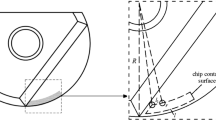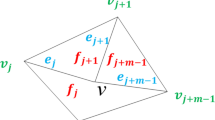Abstract
Preliminary study on slicing technology and design theory of slicing cutter shows that there is deviation between the machined tooth surface and the theoretical tooth surface, called theoretical machining error. This deviation is affected by cutter parameters and machining parameters. To improve machining accuracy, a suitable combination of parameters should be ascertained. On the other hand, interference between major flank face of the cutter and machined tooth surface of the workpiece could occur with inappropriate parameters. In addition, the constraint conditions of enough addendum thickness and no top cut also raise a claim to parameter optimization. For this purpose, the mathematical model of theoretical machining error is built. The judgment method of interference is proposed. The mathematical discriminants of enough addendum thickness and no top cut are presented. On this basis, the selectable ranges of parameters are determined by the constraint conditions. Then, orthogonal experiment is carried out to select an optimal combination of parameters by analyzing the theoretical machining error. Machining experiment is performed with the selected parameters. The results prove that the proposed optimal selection method is effective and applicable.
Similar content being viewed by others
References
Li J, Chen XC, Zhang HY (2011) Slicing technology for cylindrical gear. Chin J Mech Eng 47(19):193–198
Chen XC, Li J, Lou BC (2013) A study on the design of error-free spur slice cutter. Int J Adv Manuf Technol 68(1–4):727–738
Chen XC, Li J, Lou BC, Shi J, Yang QJ (2013) Effect of the cutter parameters and machining parameters on the interference in gear slicing. Chin J Mech Eng 26(6):1118–1126
Jain NK, Jain VK, Deb K (2007) Optimization of process parameters of mechanical type advanced machining processes using genetic algorithms. Int J Mach Tools Manuf 47(6):900–919
Zhang XM, Ding H (2013) Note on a novel method for machining parameters optimization in a chatter-free milling process. Int J Mach Tools Manuf 72:11–15
Zhang TH, Li LX, Liang FJ, Yang BR (2008) Parameter optimization of laser die-surface hardening using the particle swarm optimization technique. Int J Adv Manuf Technol 36(11–12):1104–1112
Hamdan A, Sarhan AAD, Hamdi M (2012) An optimization method of the machining parameters in high-speed machining of stainless steel using coated carbide tool for best surface finish. Int J Adv Manuf Technol 58(1–4):81–91
Raja SB, Baskar N (2012) Application of particle swarm optimization technique for achieving desired milled surface roughness in minimum machining time. Expert Syst Appl 39(5):5982–5989
Chen JSB, Huang YK, Chen MS (2005) Feedrate optimization and tool profile modification for the high-efficiency ball-end milling process. Int J Mach Tools Manuf 45(9):1070–1076
Senthilkumaar JS, Selvarani P, Arunachalam RM (2012) Intelligent optimization and selection of machining parameters in finish turning and facing of Inconel 718. Int J Adv Manuf Technol 58(9–12):885–894
Baskar N, Asokan P, Saravanan R, Prabhaharan G (2006) Selection of optimal machining parameters for multi-tool milling operations using a memetic algorithm. J Mater Process Technol 174(1–3):239–249
Pawar PJ, Rao RV (2013) Parameter optimization of machining processes using teaching–learning-based optimization algorithm. Int J Adv Manuf Technol 67(5–8):995–1006
Komanduri R, Hou ZB (2004) Thermal analysis of laser surface transformation hardening—optimization of process parameters. Int J Mach Tools Manuf 44(9):991–1008
Yuan J, Wang KS, Yu T, Fang ML (2008) Reliable multi-objective optimization of high-speed WEDM process based on Gaussian process regression. Int J Mach Tools Manuf 48(1):47–60
Ramakrishnan R, Karunamoorthy L (2006) Multi response optimization of wire EDM operations using robust design of experiments. Int J Adv Manuf Technol 29(1–2):105–112
Mahapatra SS, Patnaik A (2006) Optimization of wire electrical discharge machining (WEDM) process parameters using Taguchi method. Int J Adv Manuf Technol 13(6):494–502
Palanisamy P, Rajendran I, Shanmugasundaram S (2007) Optimization of machining parameters using genetic algorithm and experimental validation for end-milling operations. Int J Adv Manuf Technol 32(7–8):644–655
Mukherjee R, Chakraborty S (2013) Selection of the optimal electrochemical machining process parameters using biogeography-based optimization algorithm. Int J Adv Manuf Technol 64(5–8):781–791
Huynh TV (2011) Orthogonal array experiment in systems engineering and architecting. Syst Eng 14(2):208–222
Author information
Authors and Affiliations
Corresponding author
Rights and permissions
About this article
Cite this article
Li, J., Wang, P., Chen, XC. et al. A study on the optimal selection of spur slice cutter parameters and machining parameters. Int J Adv Manuf Technol 82, 407–417 (2016). https://doi.org/10.1007/s00170-015-7369-7
Received:
Accepted:
Published:
Issue Date:
DOI: https://doi.org/10.1007/s00170-015-7369-7




